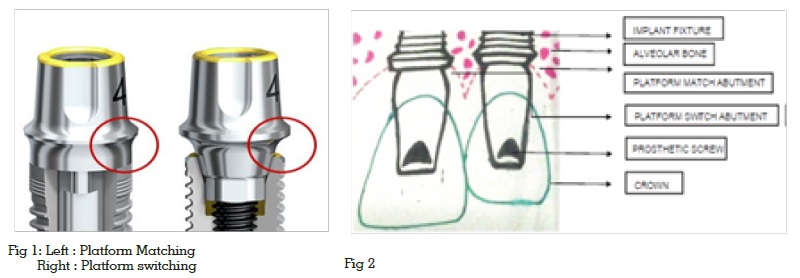

Platform switching is a newer concept in implant dentistry for controlling postrestorative crestal bone levels as a means of limiting circumferential bone loss around dental implants. It is a restorative protocol which has been reported by Dr Richard Lazzara The platform switching concept implies the use of prosthetic components having a platform diameter undersized when compared to the diameter of the implant platform. In this way, the prosthetic connection is displaced horizontally inwards from the perimeter of the implant platform, creating an angle, or step, between the abutment and implant. The mechanism by which this stepped effect may contribute to maintenance of marginal bone height and horizontal dimension of the step allows for an additional area where biologic attachment may take place, thus limiting the extent to which physiologic remodeling of the bone crest must take place to accommodate the biologic zone This review article emphasis on the importance of platform switching which increases the longevity of dental implants.
Key words: Crestal bone loss, Longevity of the Implants, Aesthetics.
The goal of modern dentistry is to provide patients with good oral health in a predictable fashion. The partial and completely edentulous patient may not have normal masticatory function, good esthetics, and phonation with a traditional removable prosthesis. When wearing a removable denture, usually the patients masticatory ability will be reduced to one-sixth of the level formerly experienced with natural dentition.1 An ideal implant prosthesis can bring back normal muscle activity and thereby improving the masticatory function. The most important criteria for the success of dental implants are the presence of good quantity and quality of bone around the implants.The longevity of dental implants is highly dependent on integration between implant components and oral tissues. Implant is regarded as successful if bone loss around the implant is up to 2 mm during the first year of implant function. In implant dentistry, platform switching (PLS) (fig1) is a method used to preserve alveolar bone levels around dental implants. The concept refers to placing restorative abutment of narrower diameter on implants of wider diameter, rather than placing abutments of similar diameters, referred to as platform matching (PLM) (fig1)
Discovered by accident in the late 1980’s, the benefits of PLS have become the focus of implant related research with increasing frequency. It can be considered a means of preventing initial periimplant bone loss. Introduction of wide diameter implants in the late 1980s created a situation, in which mismatch standard diameter abutments were used simply because of lack of commercial availability of components to match the widediameter implants. The consequence of this form of treatment was an unintentional “change of platform,” which became known as “PLS.” Serendipitously, it was found that these implants exhibited less than expected initial crestal bone loss. Several early clinical reports demonstrated enhanced soft and hard tissue responses to these platform-switched implants, leading many implant companies to incorporate PLS into their implant systems even for narrower body implants.


Many factors contribute to marginal bone loss around implants and its solution cannot be attributed to any single parameter. However, an appropriate understanding and use of platform switching concept in routine treatment improves crestal bone preservation and controlled biologic space repositioning. It appears to be a promising tool in preserving peri implant bone and further research is needed to substantiate its application in contemporary implantology.